 Cats and dogs’ eyes are similar to ours, except they have a thin third eyelid, called a nictitating membrane, between the eye and the eyelid which acts as a shield to protect the animal from environmental hazards. The third eyelid also has an additional lacrimal (tear) gland.
Cats and dogs’ eyes are similar to ours, except they have a thin third eyelid, called a nictitating membrane, between the eye and the eyelid which acts as a shield to protect the animal from environmental hazards. The third eyelid also has an additional lacrimal (tear) gland.
Some of the eye problems your dog or cat may develop include:
- Cataracts
- Conjunctivitis
- Corneal ulcers
- Glaucoma
- Infections, inflammation, and abscesses
- In-growing eyelids
- Injuries
- Macular edema
- Pannus
- Progressive Retinal Atrophy
If you notice a serious eye problem, take your pet to a holistic veterinarian right away, preferably one with experience dealing with eye problems, as it’s a rather specific field. Besides the illnesses outlined above, our dogs and cats’ eyes are reflective of their general health, and there are probably related deviances in the animal’s body.
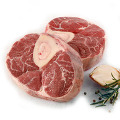 If your pet has been raised on a nutritious, raw meat diet, is not from an inbred line, and has had a healthy existence including adequate exercise and a toxic-free environment, you probably will never encounter an eye problem. For prevention of all diseases, feed a well-balanced raw diet that includes fish oil and red, yellow, or orange fruits or vegetables. These will supply your pet with retinoids and carotenoids. If you have an
If your pet has been raised on a nutritious, raw meat diet, is not from an inbred line, and has had a healthy existence including adequate exercise and a toxic-free environment, you probably will never encounter an eye problem. For prevention of all diseases, feed a well-balanced raw diet that includes fish oil and red, yellow, or orange fruits or vegetables. These will supply your pet with retinoids and carotenoids. If you have an  animal that you believe is particularly susceptible to a certain eye problem, see the specific condition, below, and perhaps give supplements of eyebright and lutein. If you have a German shepherd, read the section on pannus, below, for specific precautionary measures.
animal that you believe is particularly susceptible to a certain eye problem, see the specific condition, below, and perhaps give supplements of eyebright and lutein. If you have a German shepherd, read the section on pannus, below, for specific precautionary measures.
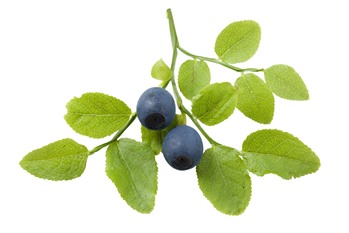 Bilberry improves capillary circulation
Bilberry improves capillary circulation
in the eyes and throughout the body, and has been known to strengthen the ocular system. Also, herbs that promote healthy circulation, such as cayenne, may improve vision. See Heart Disease. And any plan to prevent or treat vision problems should also work on supporting the liver, as good liver health is crucial to healthy eye function. Milk Thistle is an example of a detoxifier and liver supporter. See Liver Disease.
Some breeds are prone to overgrown hair rubbing their eyes or contributing to tear duct problems. The hair can also carry germs, so you ought to trim it to eliminate the hazard. 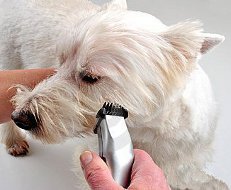 Also, if your dog likes to hang its head out the window when riding in the car, the wind may be an irritant. There’s also the possibility that a foreign particle could get lodged in the dog’s eye this way.
Also, if your dog likes to hang its head out the window when riding in the car, the wind may be an irritant. There’s also the possibility that a foreign particle could get lodged in the dog’s eye this way.
There are many things you can do to help protect the healthy eyesight of your pet. For specific problems, we will address each condition separately, below.
Cataracts
In the middle of the eye, the lens refracts images as light patterns to the back of the eye, where the retina sends the image information through the optic nerve. A cataract is a cloudiness of the lens which obstructs the passage of light to the retina.
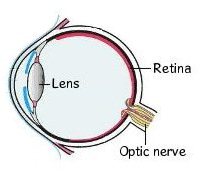 In healthy eyes, the lens adapts by contracting and stretching in response to viewing images nearby and far away, depending on what we are looking at. In the beginning stages of cataract development, the lens contracts too much, not aptly adapting when viewing distant objects, which are then perceived as blurry. This is nearsightedness.
In healthy eyes, the lens adapts by contracting and stretching in response to viewing images nearby and far away, depending on what we are looking at. In the beginning stages of cataract development, the lens contracts too much, not aptly adapting when viewing distant objects, which are then perceived as blurry. This is nearsightedness.
Cataracts usually develop slowly, and can lead to blindness if not treated. Most of the time both eyes will develop cataracts, but one eye usually starts before the other.
 Cataracts are common in older dogs, and are seen less frequently in cats. They often occur in pets with diabetes, allergies, chronic skin problems, immune system disorders, hip dysplasia, ear problems, and pets who have been given recurring steroid injections. Cataracts can also be caused by genetic inheritance, an injury to the eye, and malnutrition.
Cataracts are common in older dogs, and are seen less frequently in cats. They often occur in pets with diabetes, allergies, chronic skin problems, immune system disorders, hip dysplasia, ear problems, and pets who have been given recurring steroid injections. Cataracts can also be caused by genetic inheritance, an injury to the eye, and malnutrition.
Most veterinarians believe there’s not a lot you can do once your pet has developed cataracts, other than surgery. Cutting into the eye and having the lens surgically removed is not an optimal solution. Unfortunately, we often don’t research the condition until our pet has it. And, in this case, the best offense is a good defense. If our pets have one of the conditions that preludes cataract development, listed above, we need to work at treating that condition.
As well, it’s imperative to feed a healthy, balanced diet made of raw foods. If your pet is predisposed to cataract development, pay particular attention to carotenoids, which are concentrated in red,  yellow, and orange fruits and vegetables, and be sure to include fish oil in the diet. Puppies and kittens who don’t receive adequate amounts of essential nutrients are prone to develop cataracts later in life. Deficiencies in amino acids such as taurine, arginine, histidine, methionine, and phenylalanine have been linked to cataracts.
yellow, and orange fruits and vegetables, and be sure to include fish oil in the diet. Puppies and kittens who don’t receive adequate amounts of essential nutrients are prone to develop cataracts later in life. Deficiencies in amino acids such as taurine, arginine, histidine, methionine, and phenylalanine have been linked to cataracts.
Herbal and Naturopathic Help
 As described above, nutrition is the most effective preventative. Make sure your pet’s natural diet contains adequate amounts of retinoids, carotenoids, antioxidants, amino acids, and essential fatty acids. Aside from that, Cineraria drops can be applied topically to the eye.
As described above, nutrition is the most effective preventative. Make sure your pet’s natural diet contains adequate amounts of retinoids, carotenoids, antioxidants, amino acids, and essential fatty acids. Aside from that, Cineraria drops can be applied topically to the eye.
In Keep Your Dog Healthy the Natural Way, Pat Lazarus recounts a number of cases in which veterinarians either cured a dog of cataracts or, at least, stopped the progression of the disease. One such case involved a mixed breed terrier who was taken to Dr. Norman Ralston. Using nutrition and homeopathy, Dr. Ralston helped the dog go from almost complete blindness from cataracts to being able to see excellently. Dr. Ralston tells about a time when the dog’s owner noticed the terrier fixatedly staring at something in the yard, through the screen door. The owner looked out and couldn’t see anything. Finally, she noticed a squirrel that was about a hundred yards away. The dog was fourteen at that time.
And Dr. John Fudens reports of many cases in which cataracts in dogs were completely cleared up. His treatments begin with a cleansing of the system. Since the cloudiness of cataracts is made of toxins, this is a logical first step.
 One of Dr. Fudens patients was a wire-haired Terrier named Mozart. When Mozart was brought to Dr. Fudens, the dog had cataracts in both eyes and was suffering from skin conditions. Dr. Fudens is quoted as noting that the dog “was highly toxic from heavy vaccination, commercial foods, cortisone given for skin itch, et cetera.”
One of Dr. Fudens patients was a wire-haired Terrier named Mozart. When Mozart was brought to Dr. Fudens, the dog had cataracts in both eyes and was suffering from skin conditions. Dr. Fudens is quoted as noting that the dog “was highly toxic from heavy vaccination, commercial foods, cortisone given for skin itch, et cetera.”
It took the doctor up to five months to detoxify Mozart of the toxins from the vaccines, drugs, and poisons that had racked his body. He used homeopathic detoxifiers such as Thuja and Nux vomica. He also put the dog on a natural diet, gave him liver glandular extract, glandular immune support, and Chinese herbs. For the dog’s skin problem, Dr. Fudens made sure Mozart had proper quantities of unsaturated fatty acids.
Dr. Fudens reported, “…having cleaned out his body of the drugs, vaccines, and other poisons – I started him on a constitutional, silica, for the cataracts. My records tell me that in less than two months, the cataracts were almost gone.” After the silica treatment, Dr. Fudens administered another constitutional, sulfur. “By then,” the veterinarian told Pat Lazarus, “Mozart had no cataracts at all. But he still had some remaining skin problems, which cleared up immensely with the sulfur.” Three years later, Mozart was reported as having clear skin and clear eyes.
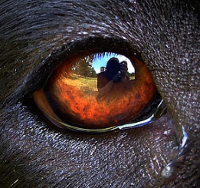 Dr. Richard Kearns is quoted in Lazarus’s book, explaining that “cataracts are basically accumulations of toxins in the eyes […]. Dogs and people have several types of tears, and one type is an oil. Nowadays there are a lot of unnatural hydrogenated oils in our diets and those of our pets. And when these oils get broken down in the body, it doesn’t know how to handle them. So eventually these unnatural oils make their way out into the eye and cause mutations in the lens that are known as cataracts.”
Dr. Richard Kearns is quoted in Lazarus’s book, explaining that “cataracts are basically accumulations of toxins in the eyes […]. Dogs and people have several types of tears, and one type is an oil. Nowadays there are a lot of unnatural hydrogenated oils in our diets and those of our pets. And when these oils get broken down in the body, it doesn’t know how to handle them. So eventually these unnatural oils make their way out into the eye and cause mutations in the lens that are known as cataracts.”
Therefore, the more natural your dog or cat’s diet is, the less chance they have of developing cataracts and other diseases. Fats, themselves, are not the culprit. Both species require a certain amount of natural fats. It’s the unnatural fats, which are found in processed foods, which are bad for your pet. In the same book, Dr. Kearns warns that if cataracts are cleared up, but the pet is still on a diet consisting of unnatural foods, the cataracts will come back.
There are a number of naturopathic and herbal therapies used to treat cataracts. Glutathione, retinoids (vitamin A), selenium, vitamin E, and vitamin B15 are examples, but you need to consult with a veterinarian who has expertise in this field. And if you do administer B15, make sure to also 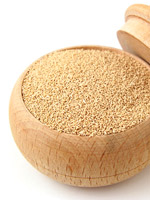 supplement the diet with a complex B vitamin. Giving just one of the B vitamins can cause deficiencies in the other B vitamins.
supplement the diet with a complex B vitamin. Giving just one of the B vitamins can cause deficiencies in the other B vitamins.
Lazarus makes an interesting point: “…when vitamin B15 was first discovered and early researchers set to work to discover what health benefits it might have, they were discouraged – because the only benefit they could find was that it dissolved cataracts in dogs’ eyes.”
Homeopathy
If the cataract is a result of an injury to the eye, and you’re sure of it, give Conicum maculatum 6c once daily for ten days. Allow no food or water for ten minutes before or after treatment.
If your pet has had any of the associated diseases listed above, 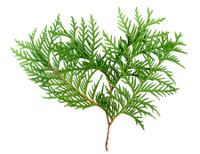 talk to a holistic or homeopathic veterinarian about treatment. Homeopathic treatments that have been helpful include Calcarea fluorica, Natrum muriaticum, and Phosphorus, but each is very specific to certain conditions. Also, detoxifiers have been helpful, such as Thuja, which is used if the animal has been vaccinated.
talk to a holistic or homeopathic veterinarian about treatment. Homeopathic treatments that have been helpful include Calcarea fluorica, Natrum muriaticum, and Phosphorus, but each is very specific to certain conditions. Also, detoxifiers have been helpful, such as Thuja, which is used if the animal has been vaccinated.
Conjunctivitis
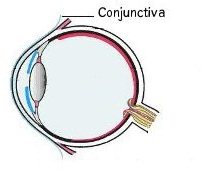 Conjunctivae are mucus membranes that cover the whites of the eyes and the insides of the eyelids. Conjunctivitis, otherwise known as pinkeye, is inflammation or infection of the conjunctiva, resulting in red or pinkness around the eyes, which may be accompanied by mucus or pus discharge.
Conjunctivae are mucus membranes that cover the whites of the eyes and the insides of the eyelids. Conjunctivitis, otherwise known as pinkeye, is inflammation or infection of the conjunctiva, resulting in red or pinkness around the eyes, which may be accompanied by mucus or pus discharge.
In dogs and cats, conjunctivitis is caused by the presence of some sort of irritant, be it an infection, allergen, or other aggravating matter. Viral or bacterial infections are airborne and easily spread among animals. People, though, can’t catch infectious pinkeye from cats and dogs because the bacteria and viruses are different.
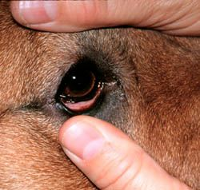 In dogs, conjunctivitis is usually caused by allergies, and the sinuses and mucus membranes may become infected. In cats, conjunctivitis is usually caused by either a viral infection such as feline herpes, or a bacterial infection such as chlamydophila. Once in a while, the problem stems from fungus or worms. Other causes in both species include blocked tear ducts, infections, irritants, corneal irregularities, and problems producing tears.
In dogs, conjunctivitis is usually caused by allergies, and the sinuses and mucus membranes may become infected. In cats, conjunctivitis is usually caused by either a viral infection such as feline herpes, or a bacterial infection such as chlamydophila. Once in a while, the problem stems from fungus or worms. Other causes in both species include blocked tear ducts, infections, irritants, corneal irregularities, and problems producing tears.
Cats often get recurring bouts of conjunctivitis because of the herpes virus. Don’t confuse this with the herpes that people get. Nearly all kittens are exposed to this virus, but for most cats it’s not a problem as their immune systems keep the disease at bay. If, however, your cat’s immune system is weak, and they are unhealthy or stressed, the feline herpes virus will flare  up. Often one eye will have pain, redness, watery discharge, and squinting. Feline herpes is also referred to as FHV-1 (Feline Herpesvirus-1) and feline viral rhinotracheitis (FVR). It’s also known as feline influenza (flu) and feline coryza. For more information, see Viral Infections.
up. Often one eye will have pain, redness, watery discharge, and squinting. Feline herpes is also referred to as FHV-1 (Feline Herpesvirus-1) and feline viral rhinotracheitis (FVR). It’s also known as feline influenza (flu) and feline coryza. For more information, see Viral Infections.
There are three basic types of conjunctivitis: serous (not serious), follicular, and purulent. Serous conjunctivitis is a mild condition in which the conjunctivae look pink and slightly swollen. Discharge is clear and watery (think serum). Serous conjunctivitis in dogs is caused by irritants such as dust, wind, cold, and allergens. If your pet has allergic conjunctivitis, you may see pawing at the eyes due to itchiness. In cats, serous conjunctivitis may mark the initial  stage of feline viral respiratory disease or chlamydophila.
stage of feline viral respiratory disease or chlamydophila.
Follicular conjunctivitis is a condition in which the glands on the underside of the membranous eyelid become rough in response to an irritant. Once the irritant is removed, the roughness is still an issue.
And purulent conjunctivitis occurs when serous (mild) conjunctivitis progresses to an infection. Streptococcus and staphylococcus are the usual culprits in dogs. In cats, more common infections are those listed above, particularly feline herpes virus and chlamydophila.
Herbal and Naturopathic Help
Mild conjunctivitis may be treatable at home. First and foremost, however, you need to rule out the possibility of a foreign object, such as a thorn, lodged in the eye. If there is something wedged in there, and you try to treat the eye without removing the object, you may do permanent damage to your pet’s eye.
To check for foreign objects, you’ll need about a quart of saline water. You can make this using either distilled water or filtered water that has been boiled and regular NaCl, sodium chloride. Some  people prefer to use natural sea salt. Cooking or pickling salt also works, as long as it is plain salt. To each quart of pure water, add one teaspoon of salt. We usually test the saline solution on our own eyes, but we can’t recommend you do that because of liability reasons, so we’ll that choice up to you. The solution should be room temperature. Alternatively, you can buy saline solution.
people prefer to use natural sea salt. Cooking or pickling salt also works, as long as it is plain salt. To each quart of pure water, add one teaspoon of salt. We usually test the saline solution on our own eyes, but we can’t recommend you do that because of liability reasons, so we’ll that choice up to you. The solution should be room temperature. Alternatively, you can buy saline solution.
Make sure the bottles and equipment you use are sterile.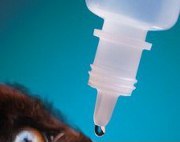 Washing in a dishwasher or with boiling water will sterilize them. Then, to examine the eye for foreign objects, gently flush the area with about a quart of saline water using a bulb syringe or squirt bottle. Carefully wipe around the eye to remove discharge. Do not wipe over the eye. Now examine the eye, being mindful that there may be something lodged under the eyelid. If there is any possibility that there is some sort of foreign object in the eye, do not attempt to treat the problem yourself. Take your pet to a holistic veterinarian.
Washing in a dishwasher or with boiling water will sterilize them. Then, to examine the eye for foreign objects, gently flush the area with about a quart of saline water using a bulb syringe or squirt bottle. Carefully wipe around the eye to remove discharge. Do not wipe over the eye. Now examine the eye, being mindful that there may be something lodged under the eyelid. If there is any possibility that there is some sort of foreign object in the eye, do not attempt to treat the problem yourself. Take your pet to a holistic veterinarian.
If, however you believe the problem is mild conjunctivitis, you may try flushing the eye three or four times daily with one of the eye treatments listed below. If you don’t see definite improvement within twenty-four hours, make an appointment with a holistic veterinarian. It’s important to find out what the root of the problem is.
Eye Washes and Drops
- Saline – See the instructions above on how to make your own saline solution, or buy premade saline. If you use one of the soothing oil treatments
 listed below, you will want to first cleanse the eye with saline.
listed below, you will want to first cleanse the eye with saline. - Almond Oil – used for mild irritation. Put one drop in each eye.
- Castor Oil – used for more irritated or inflamed eyes. Put one drop in each eye.
- Cod Liver Oil – used for eyes that are dry or ulcerated. Put one drop in each eye.
- Eyebright Infusion – Make a topical tea using one teaspoon of eyebright to one cup of pure, boiled water. Let it steep, covered, for fifteen minutes, and then use the strained liquid. Make sure your utensils are sanitized as described above. For every cup of tea, add ¼ teaspoon of salt. Use at room temperature to flush the eyes three to four times a day. Store up to two days, covered, at room temperature. Eyebright is useful when the eyes are irritated.
- Goldenseal Root Infusion – Make and use as described for Eyebright Infusion, above. Goldenseal is useful if there is a mild infection, indicated by yellowish discharge from the eyes.
- Greater Celandine Infusion – Make and use as described for Eyebright Infusion, above. Greater celandine is known to support good vision and soothe the eyes, and also to support the immune system.
- Calendula or Chamomile Infusions – Make and use as directed for Eyebright
 Infusion, above. Used as a soothing eye wash.
Infusion, above. Used as a soothing eye wash.
These herbs and oils can also be added to your pet’s diet, as a supplement. Additional vitamin C is also good if your pet is fighting an infection.
You can also use an eye wash containing boric acid. This may sound scary, but boric acid is the only acid that is safe to use on the eyes and it doesn’t sting. Boric acid is used in eye drops for humans, too, and can be good at remediating mild to moderate infections. It’s also used as an ear disinfectant. You can make your own boric acid solution with one cup of boiling water and ½ teaspoon of pharmacy grade boric acid powder. Use after the solution has cooled to room temperature. Or you can buy an eye wash with boric acid in it. Using a sterile bulb syringe or squirt bottle, flush the eye twice a day. If you don’t see definite improvement within twenty-four hours, make an appointment with a holistic veterinarian.
Recurring conjunctivitis must be tended to professionally. If left untreated, serious eye problems can fester.
Homeopathy
Because there are so many possible causes of conjunctivitis, you’ll need an appointment with a homeopathic expert who is capable of accurately diagnosing the cause of the eye condition before endeavoring to treat the eyes homeopathically
Corneal Ulcers
Cornea cells are the only cells in the body which are transparent. Instead of blood vessels, the cornea is nourished and kept moist by lacrimal tears. These corneal cells make up the transparent capsule that encompasses the eye. 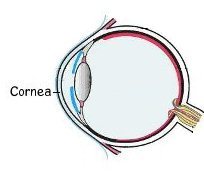 Its fragility makes the cornea susceptible to scratches and ulcers.
Its fragility makes the cornea susceptible to scratches and ulcers.
In a healthy animal, corneal scratches heal quickly. You probably won’t even notice your pet has one. The eye will be painful, and excess tears (lacrimal excretions, not rips) will form. If your pet is unhealthy, the ulcer won’t heal in a timely manner, and bacteria may grow and fester.
Older pets, unhealthy or malnourished pets, and Persian cats are prone to erosions of the cornea called ulcers. The most common cause of these ulcers is a lack of protective tears, but the ulcers can also be caused by bacterial or fungal infections or any other eye disease. Corneal ulcers can be a serious problem, and may lead to vision impairment if left untreated.
In Keep Your Pet Healthy the Natural Way, Pat Lazarus describes the therapy of a holistic veterinarian who has had a great deal of experience and success dealing with corneal ulcers. Dr. Richard Kearns uses nutritional and herbal  medicine to treat corneal ulcers, but first he often performs a simple operation that brings the animal’s third eyelid up over the ulcer. He does this because “there is not blood supply to the cornea […] that is why corneal ulcers are generally so hard to heal, because there is no way for any healing substance you put into the body to get circulated into the cornea. The third eyelid does, however, have circulation, and when placed over the ulcer, it will lend part of its circulation to the ulcer.”
medicine to treat corneal ulcers, but first he often performs a simple operation that brings the animal’s third eyelid up over the ulcer. He does this because “there is not blood supply to the cornea […] that is why corneal ulcers are generally so hard to heal, because there is no way for any healing substance you put into the body to get circulated into the cornea. The third eyelid does, however, have circulation, and when placed over the ulcer, it will lend part of its circulation to the ulcer.”
Another doctor, John Eden, points out that this simple surgery has the added benefit of protecting the ulcer from irritation every time the animal blinks, which happens thousands of times a day.
If you see blood, the eye needs to be looked at by a veterinarian. If the injury is deep, or there is debris or a foreign object stuck in the eye, you also must see a veterinarian immediately.
It’s important not to use corticosteroids in the eye if your pet has a corneal ulcer because steroids restrict the healing process.
For mild scratches you may use the following treatments.
Herbal and Naturopathic Help
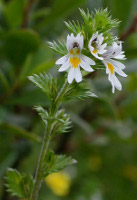 Apply a drop of cod liver oil to the eye four times daily. The oil is soothing and protective, and the vitamin A in cod liver oil will stimulate healing. Add fish oil, vitamin E, and vitamin C to the diet. See Supplement Dosage Guidelines.
Apply a drop of cod liver oil to the eye four times daily. The oil is soothing and protective, and the vitamin A in cod liver oil will stimulate healing. Add fish oil, vitamin E, and vitamin C to the diet. See Supplement Dosage Guidelines.
You may also want to use an eyebright infusion as a wash before administering the oil. See Eyebright Infusion in the conjunctivitis section.
Both fish oil and eyebright can also be given as dietary supplements. Some holistic veterinarians have had success using Chinese herbs and cartilage, as well. In Keep Your Pet Healthy the Natural Way, Lazarus inserts this quote from Dr. John Fudens, regardng a corneal ulcer he had cured using two forms of eyebright and Chinese herbs: “I also gave him Oxi-5000, which contains a number of anti-oxidants, and some shark cartilage.” That was in the late 1990’s. Now Oxi-5000 contains the enzyme, catalase, which has properties that are similar to cartilage.
The bottom line is that you need to speak to an expert with experience in your pet’s particular eye problem, and you mustn’t let it fester.
Homeopathy
Give one or two pellets of Aconitum napellus 30c every four hours for a total of three treatments. Allow no food or water ten minutes before or after treatment.
Glaucoma
Glaucoma is a group of disorders that lead to damage of the optic nerve, which can permanently impair vision, possibly to the point of blindness if left untreated. In most cases, the damage to the optic nerve is caused by intraocular pressure. This is pressure of the eye fluid, called aqueous humor, between the cornea and the lens. Aqueous humor is continuously being made in the back of the eye and circulating th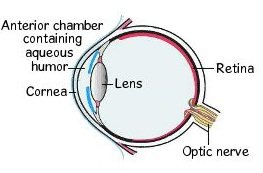 rough this frontal region, called the anterior chamber. Anything that slows or blocks this circulation causes intraocular pressure.
rough this frontal region, called the anterior chamber. Anything that slows or blocks this circulation causes intraocular pressure.
Symptoms include:
- Severe eye pain
- Red or bluish tint to the eye
- Yellowy-green discharge
- Impaired vision
- Cloudy cornea
- Dilated pupils that don’t constrict with light
- Enlargement of blood vessels in the sclera or whites of the eyes
 During later stages of glaucoma, the eye may bulge or appear enlarged.
During later stages of glaucoma, the eye may bulge or appear enlarged.
Both cats and dogs can get glaucoma, although it’s more common in dogs. Beagles, Cocker Spaniels, Basset Hounds, Miniature Poodles, and Dachshunds are at higher risk because of genetic factors. If drainage pores in the eyes are too small, or at a problematic angle, drainage becomes more difficult, and pressure builds up more easily. Other causes of glaucoma are injuries and almost all types of eye disease because disease can alter the smooth flow of aqueous humor.
If you suspect your pet has glaucoma, see a holistic veterinarian right away. Glutathione, vitamin A, Meadow Sweet, celandine, and homeopathic phosphorus are some of the treatments an expert may use, but you will need to consult with someone experienced in this field.
Infections, Inflammation, and Abscesses
Although infections and inflammation are not limited to the conjunctivae, read the section on conjunctivitis because the information is the same. Inflammation is often caused by a bacterial or viral infection. Don’t let this get out of hand. See a holistic veterinarian right away if the infection or inflammation is serious or if it doesn’t improve as noted in the conjunctivitis section.
Abscesses, as described in the section on abscesses, are cavities filled with pus which are surrounded by swollen, irritated tissue. In the book, Keep Your Pet Healthy the Natural Way, Lazarus describes a case where a veterinary ophthalmologist seeks the help of holistic veterinarian Marty Goldstein. 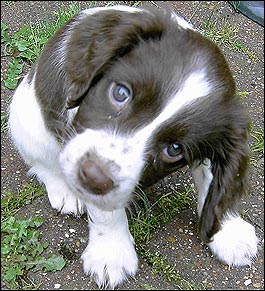 The ophthalmologist was wise enough to know that his conventional treatment wasn’t working, and humble enough to ask for advice. Doctor Goldstein cured the abscess with two treatments of acupuncture. The place he stuck the needles? The acupuncture liver point.
The ophthalmologist was wise enough to know that his conventional treatment wasn’t working, and humble enough to ask for advice. Doctor Goldstein cured the abscess with two treatments of acupuncture. The place he stuck the needles? The acupuncture liver point.
Again, you need to seek help from an experienced holistic veterinarian if your pet has an abscess or serious infection or inflammation of the eye.
In-growing Eyelids
If your pet’s eyelids are turning in toward the eye, and the lashes are rubbing on the corneal surface, you need to seek help from an experienced holistic veterinarian. The rubbing can cause a corneal ulcer, which will get worse and worse, possibly leading to blindness, if left untreated.
In Natural Health for Dogs and Cats, Dr. Richard Pitcairn explains, “This problem is not as easy to observe as you might suppose. Gently pull the lids away from the eye and let them fall back. Repeat several times. If the animal has ingrowing eyelids, you should be able to see the cuffing in of the lids as they are released. Some dogs are born with this condition, so you can see it when they are quite young. Others develop it after a long period of low-grade conjunctivitis (inner eyelid inflammation). The repeated inflammation and contraction cause the lids to turn in.”
Dr. Pitcairn states that he usually uses surgery and/or the following methods. Don’t, however, try to treat this condition all by yourself.
Herbal and Naturopathic Help
Store the following solution at room temperature, and instill two to three drops in the affected eye three times daily, making sure the solution is well mixed.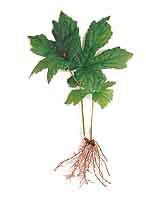
- Five drops goldenseal tincture
- ¼ teaspoon sea salt
- One cup of distilled water
Also, a drop of almond oil in the eye three times daily can be helpful for irritation.
Homeopathic
Silicea is useful in certain cases of in-growing eyelids, but if your pet has this condition, you must see a veterinarian.
Injuries
If your pet incurs a serious eye injury, or if there is any bleeding of the eye, see a veterinarian immediately.
Herbal and Naturopathic Help
Hopefully your pet is on a healthy, natural diet made of raw ingredients as described on the Diet page. Proper nutrition helps in all instances of healing and health maintenance. In addition, cod liver oil, lutein, and eyebright are known to help with vision support, and vitamin C helps, as well.
Homeopathic
 If you think the eye may just have a minor scratch or scrape, give one or two pellets of Euphrasia officinalis 30c (eyebright) every four hours for a total of three treatments. Allow no food or drink within ten minutes of treatment.
If you think the eye may just have a minor scratch or scrape, give one or two pellets of Euphrasia officinalis 30c (eyebright) every four hours for a total of three treatments. Allow no food or drink within ten minutes of treatment.
If your pet got hit in the eye, and suffered a mild blow or contusion, give Symphytum 30c with the same directions as Euphrasia, above. Use this treatment if the whole eye got hit, not if part of the eye was poked.
Macular Edema
Macular edema is a pooling of fluid causing swelling or thickening of the macula, which is the area of the retina responsible for central vision. Macular edema is often a symptom of some other condition, such as  diabetes. It’s important to see a holistic veterinarian to get to the root of the problem.
diabetes. It’s important to see a holistic veterinarian to get to the root of the problem.
In Keep Your Pet Healthy the Natural Way, Lazarus interviews Dr. S. Allen Price, who states that he uses shark cartilage for this problem. He also says that macular edema in humans “has been improved considerably with the use of shark, beef, or chicken cartilage.”
Pannus
Pannus, also referred to as chronic superficial keratitis, is a progressive disease in which blood vessels, pigment, and scar tissue spread across the cornea, causing a grayish pink or brownish film to grow over the eye. As this film spreads, the superficial vessels invade the cornea, causing vision problems which can progress to blindness if untreated. With time, the cornea becomes thickened and the surface may become rough and pitted with granulation tissue. The corneal spread usually begins at the outside corner of the eye. Both eyes are affected, but the disease doesn’t necessarily affect each eye symmetrically. The disease can 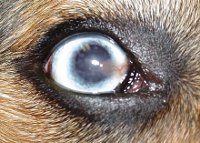 also affect the third eyelid, the nictitating membrane, in which case it’s called atypical pannus.
also affect the third eyelid, the nictitating membrane, in which case it’s called atypical pannus.
Pannus is considered an autoimmune disease because it’s believed to be an allergic reaction in which the body does not recognize its own corneal cells and attacks them. The disease seems to be triggered or exacerbated with exposure to ultraviolet light (sunlight), pollution, and high altitudes. The glare from sunlight off of water and snow is also problematic. There is still much to be learned about this disease, however.
There are reports from breeders who say that pannus seems to be occurring much more frequently in the last fifteen to twenty years. Prior to that, these breeders hadn’t even heard of the disease. This increased rate of occurrence  suggests that there is something in the diet and/or environment causing these autoimmune problems. The increase in autoimmune disorders, in general, is attributed to commercial pet foods, annual vaccinations, exposure to toxicities, and long term treatments of antibiotics, steroids, or other drugs. Inbreeding may also be a contributing factor.
suggests that there is something in the diet and/or environment causing these autoimmune problems. The increase in autoimmune disorders, in general, is attributed to commercial pet foods, annual vaccinations, exposure to toxicities, and long term treatments of antibiotics, steroids, or other drugs. Inbreeding may also be a contributing factor.
Pannus only afflicts dogs, and is often called German Shepherd Pannus because it occurs most often in that breed. Other susceptible breeds include Labradors, poodles, border collies, other shepherds, miniature pinchers, greyhounds, huskies, and Rottweilers.
Symptoms are as described above. You will notice a cloudy, pinkish-gray film growing across the eye from the outside edge. You may notice blood vessels in it. With time, the film may change to a darker brown color. You may see redness and watery lacrimal fluids at the same corner of the eye. White, fatty deposits of cholesterol or calcium may appear in the other corner. The entire  cornea may appear opaque, and vision may be impaired. In atypical pannus, the third eyelid may appear thickened or become reddish or pink in color. The condition is not usually painful unless there is also a corneal ulcer. If your veterinarian prescribes steroids, do not use them until you are sure your dog does not have an ulcer on the cornea.
cornea may appear opaque, and vision may be impaired. In atypical pannus, the third eyelid may appear thickened or become reddish or pink in color. The condition is not usually painful unless there is also a corneal ulcer. If your veterinarian prescribes steroids, do not use them until you are sure your dog does not have an ulcer on the cornea.
If you take your dog to a conventional veterinarian, and pannus is diagnosed, the vet will most likely give you a prescription for steroid drops. He or she may also prescribe cyclosporine. You will be told that treatment may control the disease, but it won’t cure it, and that lifelong treatment is necessary. In some cases, surgery may be prescribed, but most of the time you will just be given steroid drops to administer for life. Lifelong steroids, though, cause problems of their own, including corneal dystrophy. Some dogs don’t need to be on steroids for life. Consult a holistic veterinarian with experience in this field.
Herbal and Naturopathic Help
If your dog is diagnosed with pannus, you will need professional help. Don’t try to treat the condition by yourself. See a holistic veterinarian with experience dealing with this disease.
If you live in a sunny climate, get some UV-proof goggles, such as doggles. Exercise is important – your dog should get at least an hour a day. But if your dog has pannus or is susceptible to it, go on your walks, hikes, or runs in the early morning or after sunset. Stay away from snow and water on sunny days. Don’t let your dog hang its head out the window of the vehicle.
you live in a sunny climate, get some UV-proof goggles, such as doggles. Exercise is important – your dog should get at least an hour a day. But if your dog has pannus or is susceptible to it, go on your walks, hikes, or runs in the early morning or after sunset. Stay away from snow and water on sunny days. Don’t let your dog hang its head out the window of the vehicle.
A good diet is important for dogs who suffer from any autoimmune disease. Supplement a fresh, raw meat diet with extra nutrients for eye health. These include retinoids and carotenoids. A raw meat diet with added fish oil delivers natural amounts of retinoids (vitamin A). And carotenoids are found in orange, red, and yellow produce.
An eyebright eyewash is also recommended. 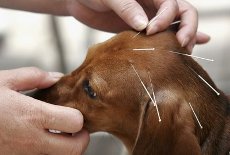 To make the eyewash, follow the steps for how to make Eyebright Infusion in the conjunctivitis section. You may also want to give your dog oral doses of eyebright.
To make the eyewash, follow the steps for how to make Eyebright Infusion in the conjunctivitis section. You may also want to give your dog oral doses of eyebright.
As well, many holistic veterinarians say that Chinese herbs and acupuncture have been helpful.
Homeopathy
Again, do not try to treat this disease yourself; you will need help from a holistic veterinarian. Ming Mu Di Huang Wan is the most common homeopathic remedy for dogs with pannus, but it is usually supplemented with other treatments.
Progressive Retinal Atrophy (PRA)
PRA is shrinking or atrophy of the blood vessels in the retina. As the name implies, the atrophy gets worse and worse, progressing eventually to total blindness. This disease is more common in dogs, particularly certain breeds because of genetic factors. For a list of these breeds, see this website.
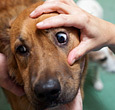 Many conventional veterinarians believe that nothing can be done for PRA, and it has been very commonly stated in veterinary medical literature that all dogs with PRA will eventually develop blindness. However, holistic veterinarians have known for decades that PRA is usually caused by not enough nutrition to the eye. In Keep Your Dog Healthy the Natural Way, Dr. Norman Ralston is quoted as saying, “You can target the nutritional deficiencies in the individual animal and treat them.” And he’s had “very good success” with holistic treatments. Two of the supplements he uses regularly are glutathione and ribonucleic acid.
Many conventional veterinarians believe that nothing can be done for PRA, and it has been very commonly stated in veterinary medical literature that all dogs with PRA will eventually develop blindness. However, holistic veterinarians have known for decades that PRA is usually caused by not enough nutrition to the eye. In Keep Your Dog Healthy the Natural Way, Dr. Norman Ralston is quoted as saying, “You can target the nutritional deficiencies in the individual animal and treat them.” And he’s had “very good success” with holistic treatments. Two of the supplements he uses regularly are glutathione and ribonucleic acid.
Even some orthodox veterinarians are starting to admit that nutritional supplementation can help stop the progression of retinal atrophy, whereas, in years past, they claimed nothing could be done. 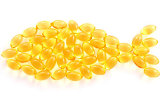 It’s been stated that complete blindness will occur within one year of diagnosis if antioxidant supplementation is not being given. These reluctant orthodox veterinarians believe that blindness is still inevitable, but naturopathy will prolong your pet’s ability to see. If your dog is one of the breeds prone to developing PRA, you would be wise to feed a natural, raw meat diet, fortified with supplements that support eye health, which are described throughout this page. And make sure your pet gets at least an hour of exercise per day. Also, watch for warning signs of early development such as dilated pupils and a glow or shine to the eyes. At this stage, the animal probably also has trouble seeing at night or in low light conditions.
It’s been stated that complete blindness will occur within one year of diagnosis if antioxidant supplementation is not being given. These reluctant orthodox veterinarians believe that blindness is still inevitable, but naturopathy will prolong your pet’s ability to see. If your dog is one of the breeds prone to developing PRA, you would be wise to feed a natural, raw meat diet, fortified with supplements that support eye health, which are described throughout this page. And make sure your pet gets at least an hour of exercise per day. Also, watch for warning signs of early development such as dilated pupils and a glow or shine to the eyes. At this stage, the animal probably also has trouble seeing at night or in low light conditions.
 In the same book mentioned above, Pat Lazarus tells of a case brought to doctors Marty and Robert Goldstein. Tina was a ten year old poodle with PRA. Veterinary ophthalmologists, eye specialists, had told Tina’s owners that there was “nothing to be done.” But the owners didn’t want to accept that. They took Tina to the doctors Goldstein, who “did an analysis of the dog’s body, found out all the ways it was out of chemical balance, and restored the balance nutritionally.” While the damage already done was not reversed, three years later, the disease had shown no signs of further progression.
In the same book mentioned above, Pat Lazarus tells of a case brought to doctors Marty and Robert Goldstein. Tina was a ten year old poodle with PRA. Veterinary ophthalmologists, eye specialists, had told Tina’s owners that there was “nothing to be done.” But the owners didn’t want to accept that. They took Tina to the doctors Goldstein, who “did an analysis of the dog’s body, found out all the ways it was out of chemical balance, and restored the balance nutritionally.” While the damage already done was not reversed, three years later, the disease had shown no signs of further progression.
Herbal and Naturopathic Help
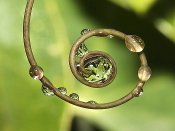 If you’re noticing signs of PRA, you must take you pet to a holistic veterinarian, preferably one with expertise in this field. You should not try to treat this condition yourself. However, here are some supplements that have been known to support eye health:
If you’re noticing signs of PRA, you must take you pet to a holistic veterinarian, preferably one with expertise in this field. You should not try to treat this condition yourself. However, here are some supplements that have been known to support eye health:
In addition, make sure your pet is eating a well-balanced raw meat diet with plenty of antioxidants. Carrots are an old standard for human eye vitality, and are also good grated up in your pet’s food because of their carotenoids.  Other sources of eye-supporting carotenoids include pumpkin, kale, squash, collard greens, and sweet potatoes. These foods need to be either minced finely or run through a food processor. Digestive enzymes help with absorption.
Other sources of eye-supporting carotenoids include pumpkin, kale, squash, collard greens, and sweet potatoes. These foods need to be either minced finely or run through a food processor. Digestive enzymes help with absorption.